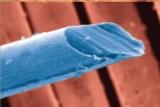A six-week field test has found that silver nanoparticle antimicrobials in textiles worn next to the skin were effective against bacteria entering the fabric through perspiration or other means while having no effect on the naturally occurring beneficial bacteria on the skin, reports Hohenstein Institute America, Inc. of Burlington, NC.
Researchers also concluded that the antimicrobial textiles had no effect on moisture transmission, pH balance, or skin condition indicating that the textiles were safe for human use.

“These results help clarify the effectiveness and safety of silver antimicrobial treatments for textiles,” said Dr. Dirk Hofer, who directs Hohenstein’s Institute for Hygiene and Biotechnology. “Many textile market segments can benefit from antimicrobial textiles, from medical applications to home textiles to workwear and athletic performancewear.”
Hohenstein’s scientists will be publishing their findings in an upcoming issue of an international dermatology journal. The research is part of a larger study commissioned by Germany’s Federal Ministry of Education and Research to understand the impact of nanotechnology on nature.
Hohenstien’s research will also focus on the environmental impacts of silver nanoparticles, which are becoming increasingly popular as a highly effective antimicrobial option for textiles. When silver-treated textiles are abraded, washed, or discarded, silver ions may be unintentionally released into the surroundings. Most scientists conclude that these silver ions are not an ecological threat as they bond with other elements to form harmless compounds, but until Hohenstein’s study, no scientific surveys have been undertaken to prove the hypothesis.















